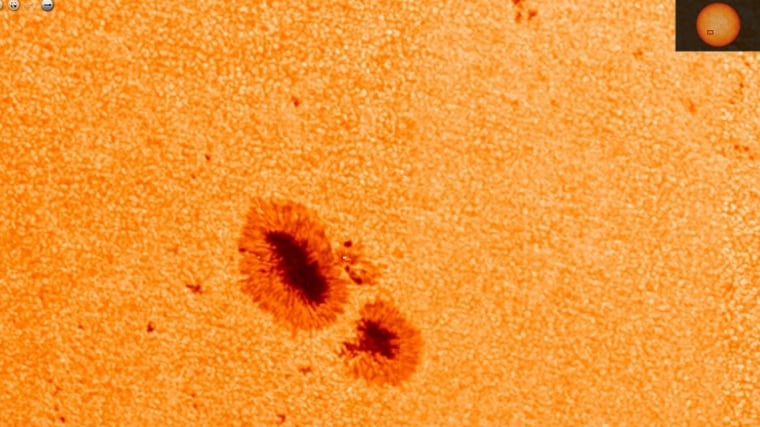Although it governs many aspects of our lives, the Sun still has many questions, such as what is the mechanism that accelerates the solar wind or why the corona, which is the external part of our star’s atmosphere, is much hotter than its surface. . To answer these and other questions, the European Solar Orbiter mission was sent almost five years ago, although it is still on the way to its main objective, which is to get so close to our star from a point never seen before to take images of its poles. , has been revealing valuable information for some time now.
The latest are four images compiled from high-resolution observations made by the Polarimetric and Helioseismic Imager (PHI) and Extreme-Ultraviolet Imager (EUI) instruments, taken last March 22, 2023 less than 74 million kilometers from the Specifically, the photographs captured by PHI are the highest-resolution comprehensive views of the Sun’s visible surface to date, and include maps of the Sun’s disordered magnetic field and motion in the Sun. surface. On the other hand, the image revealed by EUI shows the bright and intriguing solar corona.
«The Sun’s magnetic field is key to understanding the dynamic nature of our home star from the smallest to the largest scales. These new high-resolution maps from Solar Orbiter’s PHI instrument show the beauty of the Sun’s surface magnetic field and flows in great detail. At the same time, they are crucial for inferring the magnetic field in the Sun’s hot corona, which our EUI instrument is capturing,” he notes in a statement. release Daniel Müller, Solar Orbiter project scientist.
The images one by one
Visible light image of the Sun
Although the overall visible light image taken by PHI is already impressive in itself, the incredible thing about these images is that they allow a zoom that reveals the shape and delimitation of the spots as they were at that moment on our star. In addition, you can observe the bright, hot plasma (charged gas) that is constantly moving.

Detailed image in visible light
Almost all of the Sun’s radiation is emitted from this layer, which has a temperature of between 4500 and 6000 °C. Beneath it, hot, dense plasma churns in the Sun’s “convection zone,” similar to magma in Earth’s mantle. As a result of this movement, the surface of the Sun takes on a grainy appearance.
However, the most striking thing about the images are the sunspots. When imaged in visible light, they look like dark spots or holes on an otherwise smooth surface. Sunspots are colder than their surroundings and therefore emit less light.

Magnetic map of the Sun
The PHI magnetic map shows that the Sun’s magnetic field is concentrated in sunspot regions. Point outward (red) or inward (blue) wherever the sunspots are. The strong magnetic field explains why the plasma inside sunspots is colder: normally, convection moves heat from the Sun’s interior to its surface, but this is altered by charged particles that are forced to follow the dense magnetic field lines in and around sunspots.

Direction of movement of surface material
The speed and direction of movement of material on the Sun’s surface can be seen on the PHI velocity map, also known as a ‘tachogram’. Blue shows motion toward the spacecraft, while red indicates motion away from the spacecraft. This map shows that, while plasma on the Sun’s surface generally rotates with the Sun’s overall spin around its axis, it is pushed outward around sunspots (where despite being in a blue zone, there are also areas red).

Image taken in ultraviolet light
Finally, the image taken in ultraviolet light of the solar corona (the most superficial layer of the Sun’s atmosphere, on its surface) obtained by EUI shows what happens above the photosphere. Above active sunspot regions, bright plasma is seen protruding. The million-degree plasma follows magnetic field lines that protrude from the Sun and often connect neighboring sunspots.
A complex maneuver
Since Solar Orbiter was 74 million kilometers from the Sun – which in cosmic terms is almost touching it – the instruments could only capture a small portion of our star. Therefore, the full images were created from small shots in which the spacecraft needed to be tilted and rotated until every part of the Sun’s face was photographed.
To obtain the full disk images presented here, all images were stitched together as a mosaic. The PHI and EUI mosaics are composed of 25 images each, captured over a period of more than four hours. The solar disk has a diameter of almost 8000 pixels in the full mosaics, revealing an incredible amount of detail.
The image processing required to obtain the PHI mosaics was new and difficult. Now that it has been done once, processing the data and assembling the tiles will be faster in the future. The PHI team hopes to provide high-resolution mosaics twice a year.
#Solar #Orbiter #mission #reveals #images #Sun #million #kilometers


